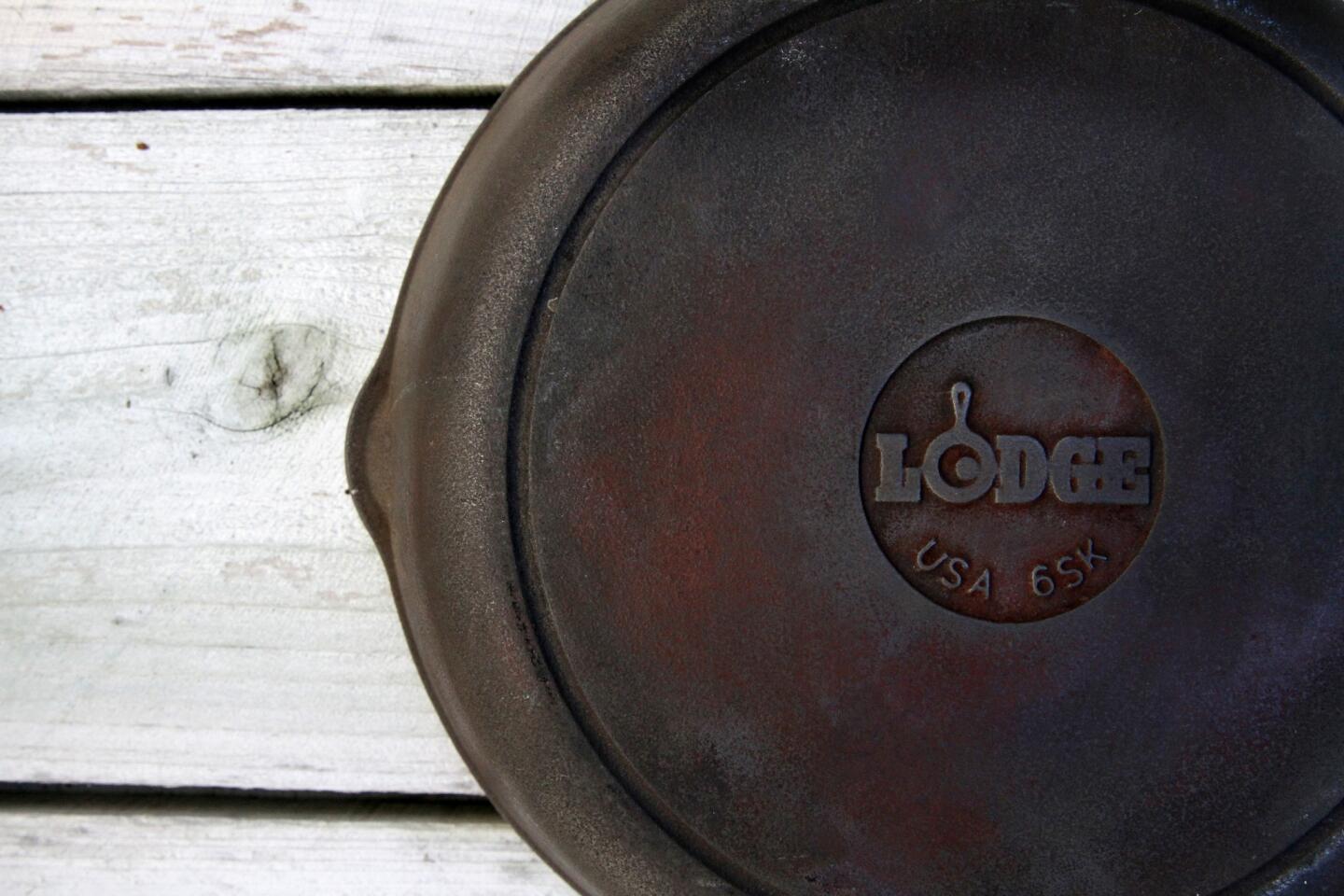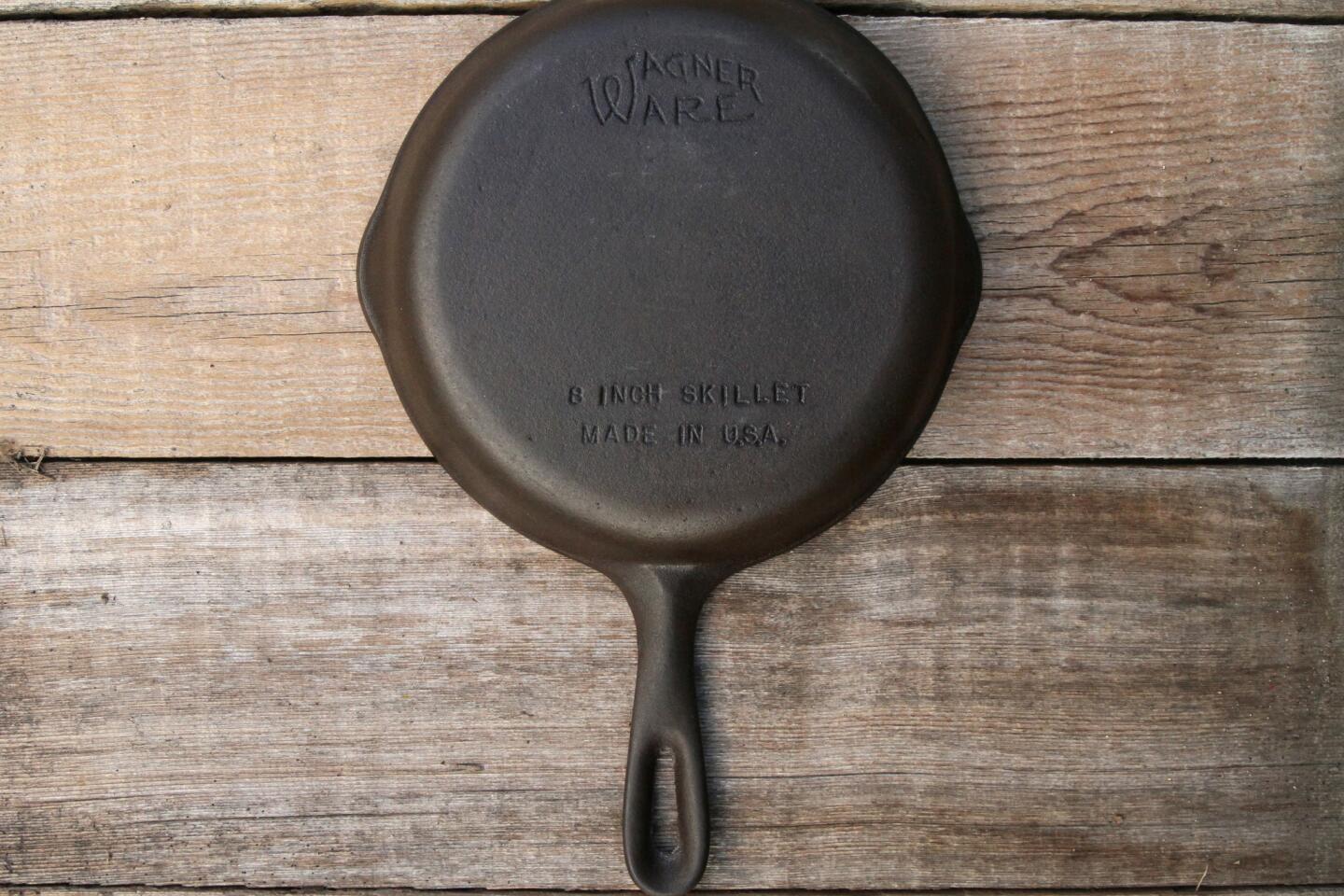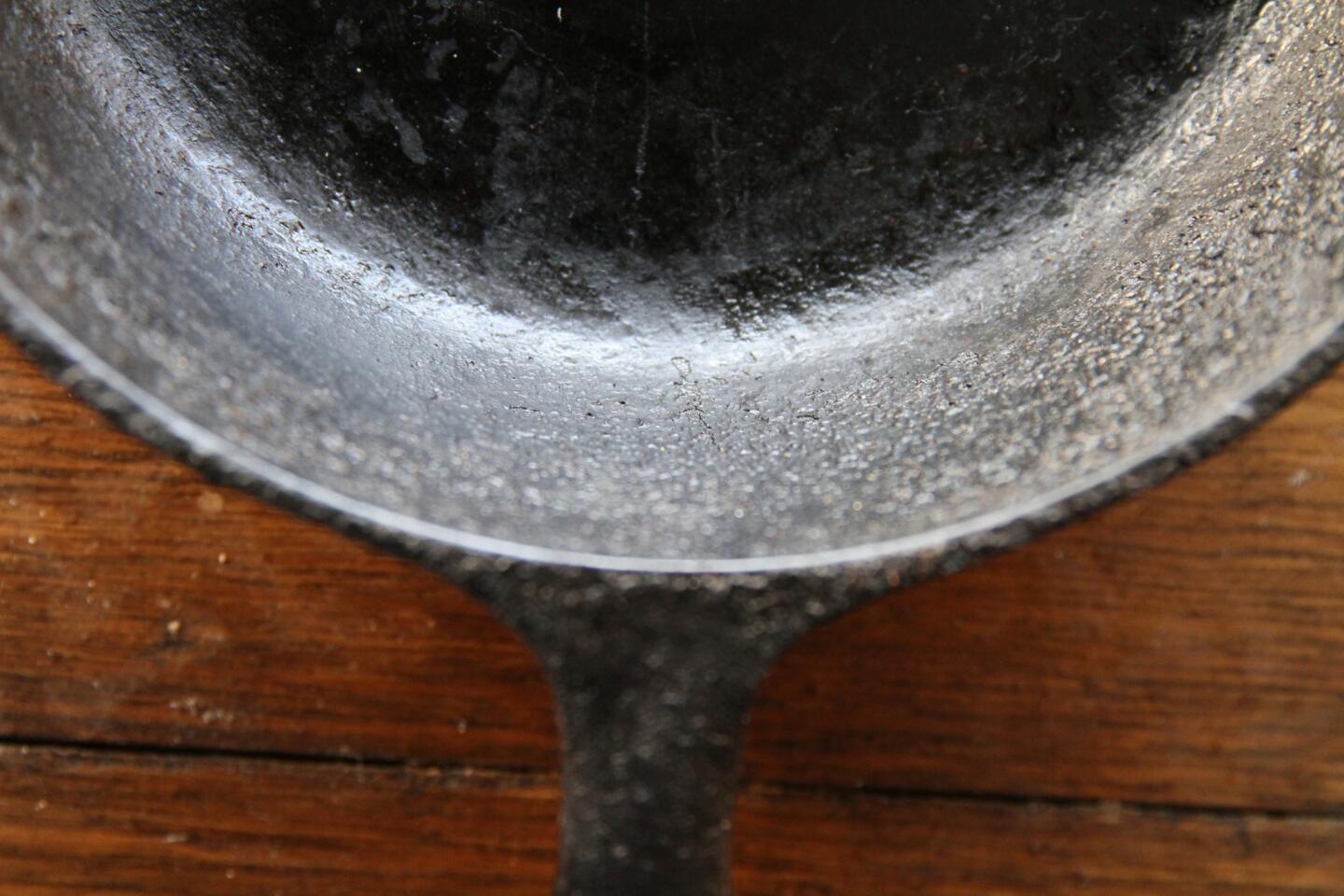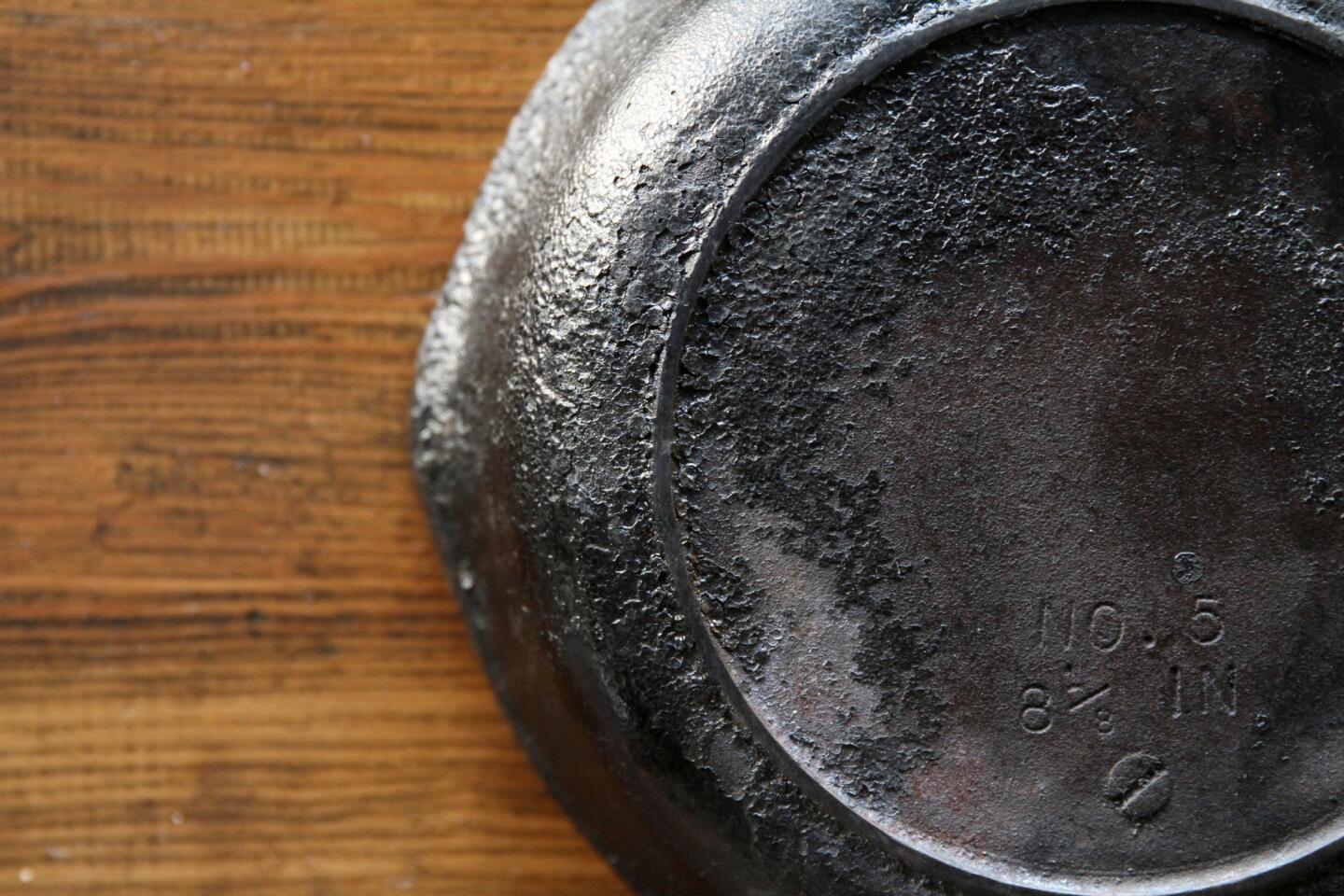How to restore old cast iron pans
- Share via
Next to knives, cooks tend to be most obsessed with their pots and pans. But with all the prestige brands out there, many of us overlook an underappreciated, far less expensive choice staring right at us — the humble, old-school, cast iron pan.
Your grandmother swore by her cast iron skillet for a reason. With just a minimal amount of maintenance, cast iron is a workhorse that can work for frying, sauteing and searing — perfect for hash browns when you’re wanting to replicate diner food, or for a French omelet when you’re channeling your inner Julia Child.
While the venerable Lodge Manufacturing Co. still produces its cast iron cookware in South Pittsburg, Tenn., there’s something satisfying about hunting down a vintage piece at a flea market, thrift store or yard sale and then bringing it back to life yourself, resurfaced and freshly re-seasoned. (You can spend as much as $200 for a restored vintage pan.)
Here are a few simple steps for removing decades of built-up, encrusted residue on older, neglected pans, instructions on how to season them and simple maintenance tips to keep them in great condition well into the future.
1. Remove encrusted buildup
There are two ways to do this. Option 1 is to use an oven cleaner, spraying it directly onto the pan, allowing it to set and then washing the stuff off with water. This method usually involves repeated applications, depending on the thickness of the built-up residue.
The second option is to make a lye bath. You’ll need two heavy-duty, plastic trashcans, with lids to fit, that are large enough to hold the number of pans you plan on stripping, a third container for final rinsing, a pair of chemical-resistant gloves and safety goggles. Lye is very caustic, so as a safety precaution, wear full clothing, gloves and goggles, and work outdoors.
Measure water into one of the trashcans in five-gallon increments. Next, add one pound of lye crystals to every five gallons of water, stirring with a wooden spoon or paint stick to dissolve. (Warning: Always add lye to the water. Never place the lye in first. Adding water to the lye will create a chemical reaction that causes the solution to boil up furiously, potentially splashing on your skin or eyes.)
Gently lower the pans into the bath, making sure they’re completely submerged, and allow to soak. Depending on how thickly encrusted the pans were, it may take a few days to several weeks for the lye to soften and dissolve the surface buildup, so begin checking the pans after a few days.
Using a soft, plastic scrub-brush or sponge, wipe the surface of the pan to see how much buildup can be removed. If some areas remain encrusted, put the pan back into the lye bath for a few more days, until more of the buildup has dissolved. Resist the urge to use abrasive metal scrubbers, wire brushes or coarse scouring pads, as they’ll scratch the pan’s surface.
When the pans have been sufficiently soaked, fill the second trashcan halfway with clean water to use as a rinse bath. Once you’re satisfied with the stripping of a pan’s buildup, transfer it the rinse bath. Using a plastic scrub brush or sponge, rinse the pan thoroughly, removing the rest of the buildup.
Cast iron can remain in the lye bath indefinitely without damage to the iron. Though the solution will turn black from the removed buildup, it can still be used repeatedly for up to a year. Some dark spots might remain on pans after the lye bath, but these will disappear once the seasoning process turns the entire surface black.
Immediately after removing the pan from the rinse water it’s important to neutralize any lye remaining on the pan. In a separate container, mix a solution of one part distilled vinegar and one part water. Again, make sure the pan is completely submerged in the solution and soak it for 30 minutes. Vinegar is very acidic and will not only neutralize the lye, it will also remove any rust that has begun to form on the surface due to oxygen exposure.
If you discover a few patches of buildup still remaining, scrub the area with a piece of super-fine steel wool and return the pan to the vinegar bath to soak for another 15-20 minutes. Rinse the pan with clear water and dry thoroughly.
2. Seasoning
Once the pan is clean, it’s important to season it immediately to prevent it from rusting. Seasoning a cast iron pan involves sealing the iron surface with a protective food-grade oil coating. Use flaxseed oil for this.
Prepare the pan for seasoning by placing it in a 200-degree oven for 10 minutes. Wearing oven mitts, take the pan out of the oven and, using a paper towel or clean rag, rub a thin coat of flaxseed oil on the hot pan. Thoroughly coat the pan’s entire surface, including the handle. With a fresh paper towel or clean rag, wipe away most of the remaining oil, leaving just a thin coat on the pan.
Increase the oven temperature to 500 degrees and return the oiled pan, upside down, to the oven. After an hour, turn the oven off, but allow the pan to remain inside to cool. Repeat this seasoning process three to five times before cooking with the pan.
3. Care and use
It’s easy to preserve and maintain your newly seasoned pan. Don’t use soap when washing, as soap will remove the polymer coating you worked so hard to build up. Instead, simply rinse the pan with hot water and use a non-abrasive scrub sponge — you can also use a bit of salt. And be sure to dry the pan immediately.
After repeated use and cleaning, you may notice the beautiful, matte-black, seasoned surface beginning to dull, and foods beginning to stick. Another application of flaxseed oil will restore the surface. Once seasoned, never heat the pan for prolonged periods without something in it. Also avoid cooking acidic foods such as tomatoes for long periods of time, as they may react with the iron and impart a sour flavor to the food.
To find, restore and cook with an old and enduring cast iron pan is to cherish it, nearly as much as a favorite knife.
Joseph Shuldiner is the founder and director of the Institute of Domestic Technology, a modern home economics university in Los Angeles.
ALSO:
5 Mason jar hacks, including a sippy cup for grown-ups
Civil Coffee is coming to Highland Park, with free coffee on opening day
Want a free Crunchwrap? Just thank Lorenzo Cain and the World Series
More to Read
Eat your way across L.A.
Get our weekly Tasting Notes newsletter for reviews, news and more.
You may occasionally receive promotional content from the Los Angeles Times.













